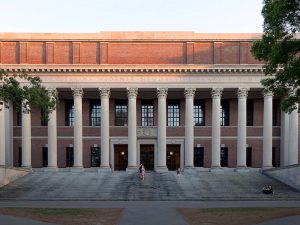10 Best National Universities For 2018: Are They Worth It?

Best National Universities, No. 10: California Institute of Technology
Determining criteria: The California Institute of Technology costs around $49,908 per year in tuition and fees with $14,796 in room and board, and it boasts a student enrollment of 979 undergraduate (2,240 altogether). U.S. News and World Report has deemed it the best on the grounds that it features a student-faculty ratio of 3:1, and the school has 67.4 percent of its classes with fewer than 20 students. The most popular majors at California Institute of Technology include: Engineering; Computer and Information Sciences and Support Services; Physical Sciences; Mathematics and Statistics; and Biological and Biomedical Sciences. The average freshman retention rate, an indicator of student satisfaction, is 97 percent.
What It’s Like to Go There: Scot Fagerland had this to say about attending Caltech. “Caltech is academic to the extreme. It is a giant leap from high school — any high school — to an academic institute. It’s just a different world. In high school, the focus was on you; at a school like Caltech, the professors are the stars of the show. The professors are very best at what they do in the lab or the journals. They were not culled for their knack at teaching newbies, and most are not particularly good at it. Learning was difficult. I noticed that the prefaces for almost all of my undergrad textbooks described them as 1st – 2nd year graduate textbooks. Somehow I managed to acquire some academic maturity along the way and muddle through some hard classes. Eventually, I realized that, “If it’s learnable, I can learn it.” That’s the confidence element. The humility should be self-evident. To go from # 1 at your high school to a middle-of-the-road kid who is really clueless in most classes is a wake-up call. But it is good to be inspired like that.”
No. 9: Duke University
Determining criteria: Duke University costs around $53,744 per year in tuition and fees with $15,500 in room and board, and it boasts a student enrollment of 6,609 undergraduate (15,928 altogether). U.S. News and World Report has deemed it the best on the grounds that it features a student-faculty ratio of 6:1, and the school has 71.4 percent of its classes with fewer than 20 students. The most popular majors at Duke University include: Biology/Biological Sciences, General; Economics, General; Public Policy Analysis, General; Psychology, General; and Bioengineering and Biomedical Engineering. The average freshman retention rate, an indicator of student satisfaction, is 97 percent.
What It’s Like to Go There: Computer science major Jason Wang said he was “loving it so far,” adding that it is “a good amount of work, but (you have) a ton of time to do what you want outside of classwork. Keep in mind I’m an engineer (RIP me) and computer science (still RIP but maybe less so, esp. compared to pre-med).”
He continued: “One of the things I love about Duke is that there isn’t really any pressure, per se, to really do anything. The people, however, will be awesome enough to motivate you to work hard. The drive will come from within, not from others. There was plenty of time for me to chill with people, learn about places I’ve never been, live vicariously, and attend a few conferences in Boston and Washington D.C. And this is all within my first year.”
No. 8: University of Pennsylvania
Determining criteria: The University of Pennsylvania costs around $53,534 per year in tuition and fees with $15,066 in room and board, and it boasts a student enrollment of 10,019 undergraduate (21,826 altogether). U.S. News and World Report has deemed it the best on the grounds that it features a student-faculty ratio of 6:1, and the school has 69.7 percent of its classes with fewer than 20 students. The most popular majors at University of Pennsylvania include: Finance, General; Registered Nursing/Registered Nurse; Economics, General; Biology/Biological Sciences, General; and Political Science and Government, General. The average freshman retention rate, an indicator of student satisfaction, is 98 percent.
What It’s Like to Go There: Current student Nelson Dong declares that studying at Penn is “intense.”
“With respect to academia, I’ve experienced all-nighters on papers, late-night meetings for project presentations, long hours in the library to study for that one day where you have your Math, History and Stat finals crammed into an eight-hour time period (while this last bit of misfortune hasn’t quite befallen me, I know many friends who have had to suffer through a comparable finals schedule), etc. With respect to the social scene, I’m talking frat parties, mixers, BYOs, and all manner of alcohol-related indulgences. Except for Penn students, the weekend often starts on Thursday, or even Wednesday. Undergraduates go just as hard in their studies as they do after-hours,” Dong said.
No. 7: Stanford University
Determining criteria: Stanford University costs around $49,617 per year in tuition and fees with $15,112 in room and board, and it boasts a student enrollment of 7,034 undergraduate (16,914 altogether). U.S. News and World Report has deemed it the best on the grounds that it features a student-faculty ratio of 4:1, and the school has 70.3 percent of its classes with fewer than 20 students. The most popular majors at Stanford University include: Computer and Information Sciences and Support Services; Multi/Interdisciplinary Studies; Biological and Biomedical Sciences; Social Sciences; and Engineering. The average freshman retention rate, an indicator of student satisfaction, is 98 percent.
What It’s Like to Go There: Mike Maples, founding partner at Floodgate, writes of his experience at Stanford that he went “hoping to become a good engineer,” but it was obvious soon after arrival “that this place was different.”
“If you had an idea for a startup company, there were professors who would encourage you to drop out and try it. You could always come back. If you took a class on entrepreneurship, you would have guest lecturers like Scott McNealy, Nolan Bushnell, Adam Osbourne, Bill Campbell, Steve Jobs, Jim Clark … it was just unbelievable. And seeing people up close like this had a way of making the process of being a massively successful founder feel more real and attainable. If they could fish that rock of gold out of the river, heck … maybe others could too.”
Maples continued: “So my experience with Stanford was more than that of attending a world-class academic institution … It also was a place where the default assumption was to be idealistic and willing to take risk.”
No. 5 (tie): Massachusetts Institute of Technology
Determining criteria: The Massachusetts Institute of Technology costs around $49,892 per year in tuition and fees with $14,720 in room and board, and it boasts a student enrollment of 4,524 undergraduate (11,376 altogether). U.S. News and World Report has deemed it the best on the grounds that it features a student-faculty ratio of 3:1, and the school has 69.6 percent of its classes with fewer than 20 students. The most popular majors at Massachusetts Institute of Technology include: Engineering; Computer and Information Sciences and Support Services; Mathematics and Statistics; Biological and Biomedical Sciences; and Physical Sciences. The average freshman retention rate, an indicator of student satisfaction, is 98 percent.
What It’s Like to Go There: Omkar Borkar shared this insight from an anonymous redditor who attended MIT. “MIT has an almost 97% graduation rate. That means that most of the people who get in, get through.
“Do you know what separates the 3% that didn’t from the rest that do? I do. I’ve seen it so many times, and it almost happened to me. Very few people get through four years of MIT with such piss-poor performance that they don’t graduate. In fact, I can’t think of a single one off the top of my head.
“People fail to graduate from MIT because they come in, encounter problems that are harder than anything they’ve had to do before, and not knowing how to look for help or how to go about wrestling those problems, burn out. The students that are successful look at that challenge, wrestle with feelings of inadequacy and stupidity, and begin to take steps hiking that mountain, knowing that bruised pride is a small price to pay for getting to see the view from the top.
“They ask for help, they acknowledge their inadequacies. They don’t blame their lack of intelligence, they blame their lack of motivation. I was lucky that I had someone to show me how to look for that motivation, and I’m hoping that I can be that person for you in some small capacity over the Internet. I was able to recover from my freshman year and go on to be very successful in my studies, even serving as a TA for my fellow students.
“When I was a senior, I would sit down with the freshmen in my dorm and show them the same things that had been shown to me, and I would watch them struggle with the same feelings, and overcome them. By the time I graduated MIT, I had become the person I looked up to when I first got in.”
No. 5 (tie): Columbia University
Determining criteria: Columbia University costs around $57,208 per year in tuition and fees with $13,618 in room and board, and it boasts a student enrollment of 6,113 undergraduate (25,084 altogether). U.S. News and World Report has deemed it the best on the grounds that it features a student-faculty ratio of 6:1, and the school has 82.9 percent of its classes with fewer than 20 students. The most popular majors at Columbia University include: Social Sciences; Engineering; Biological and Biomedical Sciences; Computer and Information Sciences and Support Services; and Visual and Performing Arts. The average freshman retention rate, an indicator of student satisfaction, is 99 percent.
What It’s Like to Go There: Alumnus Sid Mitroo says that going to Columbia, “You meet a lot of smart people and learn from them: Unless you’re a certified genius you will meet people orders of magnitude smarter than you, even if you were a top student in high school. You can probably figure out where you rank based on how many such people you encounter… if you don’t encounter any in all 4 years as an undergrad, then good for you; you’re prime to do great things with the organ in between your ears. I learnt more by having other students explain things than reading books or going to class. It’s illuminating to see how some of these ppl think and solve problems. Classes can’t teach that.”
No. 3 (tie): Yale University
Determining criteria: Yale University costs around $51,400 per year in tuition and fees with $15,500 in room and board, and it boasts a student enrollment of 5,472 undergraduate (12,458 altogether). U.S. News and World Report has deemed it the best on the grounds that it features a student-faculty ratio of 6:1, and the school has 75.2 percent of its classes with fewer than 20 students. The most popular majors at Yale University include: Economics, General; Political Science and Government, General; History, General; Psychology, General; and Cell/Cellular and Molecular Biology. The average freshman retention rate, an indicator of student satisfaction, is 99 percent.
What It’s Like to Go There: Student Charles Kenney describes his experience attending Yale, stating that he loved his freshman year “so much that I decided to come be here for the summer.”
“I could go on about the architecture, or the academic rigor, or the variety of extracurricular opportunities. But these are things one could find on official Yale websites and communications. I’d like to focus on the people.
“My freshman year roommate is the son of a philosophy professor and an English professor. He plays jazz piano incredibly well, and during the year he was picking up guitar. He and I had countless thoughtful arguments, often losing good studying hours. He is a mix of caring and deeply intellectual that makes for a really worth-while friend.
“I think he’s representative of the people at Yale. Did you have a few friends in high school who were both sterling overachievers and good, kind friends? Yale is full of people like that. You’ll find amazing mathematicians, musicians, historians, artists, anything — but more importantly, you’ll find them together, engaging in a philosophical, provocative conversation in the dining halls and common rooms.
“The one thing that never ceases to amaze me about Yalies, of any specialty, undergrad or graduate or professors, is how much they care about and engage with ideas.”
No. 3 (tie): University of Chicago
Determining criteria: The University of Chicago costs around $54,825 per year in tuition and fees with $15,726 in room and board, and it boasts a student enrollment of 5,941 undergraduate (13,322 altogether). The institute is largely used for graduate studies. U.S. News and World Report has deemed it the best on the grounds that it features a student-faculty ratio of 5:1, and the school has 77 percent of its classes with fewer than 20 students. The most popular majors at University of Chicago include: Economics, General; Biology/Biological Sciences, General; Mathematics, General; Political Science and Government, General; and Public Policy Analysis, General. The average freshman retention rate, an indicator of student satisfaction, is 99 percent.
What It’s Like to Go There: William T. Oravecz offers his perspective on what it was like to be a graduate student at the school. “The faculty was world class. They where very good. No complaints at all. I could not have been at a better place. That being said it was no cake walk what so ever. It was demanding, but I loved what I was studying and the faculty loved what they taught and researched. I had a passion for what I was studying and the interest and intellectual support of the faculty of the faculty across the University, not just in my department or school.
“Socially I made great friends living in the International House from different countries and areas of study. The city of Chicago as well as Hyde Park offered great entertainment and dining destinations.”
No. 2: Harvard University
Determining criteria: Harvard University costs around $48,949 per year in tuition and fees with $16,660 in room and board, and it boasts a student enrollment of 6,710 undergraduate (20,324 altogether). The institute is largely used for graduate studies. U.S. News and World Report has deemed it the best on the grounds that it features a student-faculty ratio of 7:1, and the school has 74 percent of its classes with fewer than 20 students. The most popular majors at Harvard University include: Social Sciences, General; Biology/Biological Sciences, General; Mathematics, General; History, General; and Physical Sciences. The average freshman retention rate, an indicator of student satisfaction, is 97 percent.
What It’s Like to Go There: Student Brian Feeny describes his life at Harvard University in the following manner (via Quora). “I read on the weekends, a lot, do homework/projects/problems, and work on stuff that is complimentary to what I am studying or coming up in the next semester. In short, the work load (for me) is intense, and I never feel comfortable until the semester is over, even though I currently carry a 4.0 average. I do regular things like goto the movies, out to dinner, etc. But the truth is a lot of my time is occupied by school.”
And No. 1 on the Best National Universities list: Princeton University
Determining criteria: Princeton University costs around $47,140 per year in tuition and fees with $15,610 in room and board, and it boasts a student enrollment of 5,400 undergraduate (8,181 altogether). The institute is one of the oldest and most easily recognizable colleges in the nation, having opened in 1746. U.S. News and World Report has deemed it the best on the grounds that it features a student-faculty ratio of 5:1, and the school has 73 percent of its classes with fewer than 20 students. The most popular majors at Princeton University include: Public Policy Analysis, General; Computer Engineering, General; Econometrics and Quantitative Economics; History, General; and Operations Research. The average freshman retention rate, an indicator of student satisfaction, is 98 percent.
What It’s Like to Go There: Lorrie Fisher, who studied at Princeton, describes her experience with the university as follows on the website Quora: “I was one of the first women to attend Princeton. I wore a pink velvet and lace jacket and they called me Sir. I am also Jewish. I lived in Wilson my first year and was befriended by students from the clubs and by “Black Separatists,” (ancient history-look it up) as well as by faculty members. Someone who enjoys people can stay engaged 24/7 without stepping foot into The Street. Hindsight has shown me that Princeton goes with a student for life. Wherever I go, I can find a group of alumni who socialize. Princeton is inclusive if you can have the good fortune to be admitted.
In closing
We hope this look at the top 10 national universities as picked by U.S. News and World Report and described by their actual students and alumni was insightful. You don’t have to attend one of these institutions, however, to get a great education or have a successful future. But do consider the experiences mentioned here as well as some of the factoring criteria for where you choose to attend.
[Featured Image by Wikipedia Commons]








